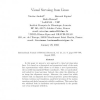Free Online Productivity Tools
i2Speak
i2Symbol
i2OCR
iTex2Img
iWeb2Print
iWeb2Shot
i2Type
iPdf2Split
iPdf2Merge
i2Bopomofo
i2Arabic
i2Style
i2Image
i2PDF
iLatex2Rtf
Sci2ools
ICRA
2000
IEEE
2000
IEEE
Visual Servoing from Lines
In this paper we present a new approach to visual servoing using lines. It is based on a theoretical and geometrical study of the main line representations which allows us to define a new representation, the so-called binormalized Pl¨ucker coordinates. They are particularly well suited for visual servoing. Indeed, they allow the definition of an image line alignment concept. Moreover, the control law which realizes such an alignment has several properties: partial decoupling between rotation and translation, analytical inversion of the motion equations and global asymptotic stability conditions. This control law was validated both in simulation and experimentally in the specific case of an orthogonal trihedron. 1
| Added | 31 Jul 2010 |
| Updated | 31 Jul 2010 |
| Type | Conference |
| Year | 2000 |
| Where | ICRA |
| Authors | Nicolas Andreff, Bernard Espiau, Radu Horaud |
Comments (0)

